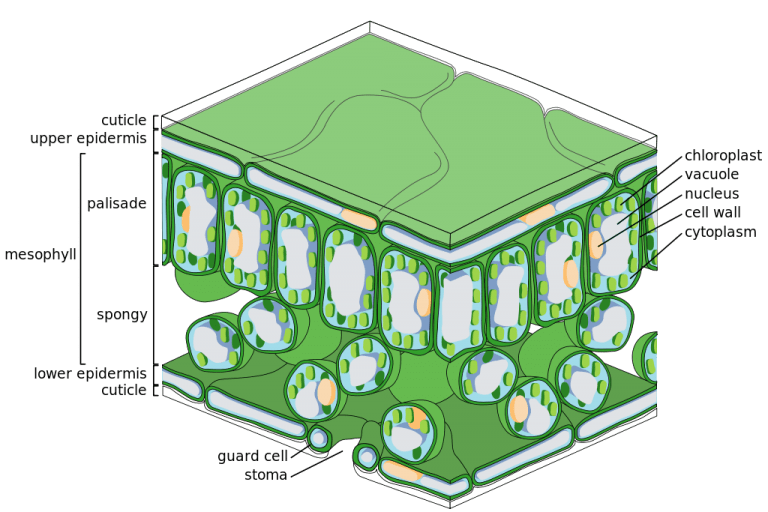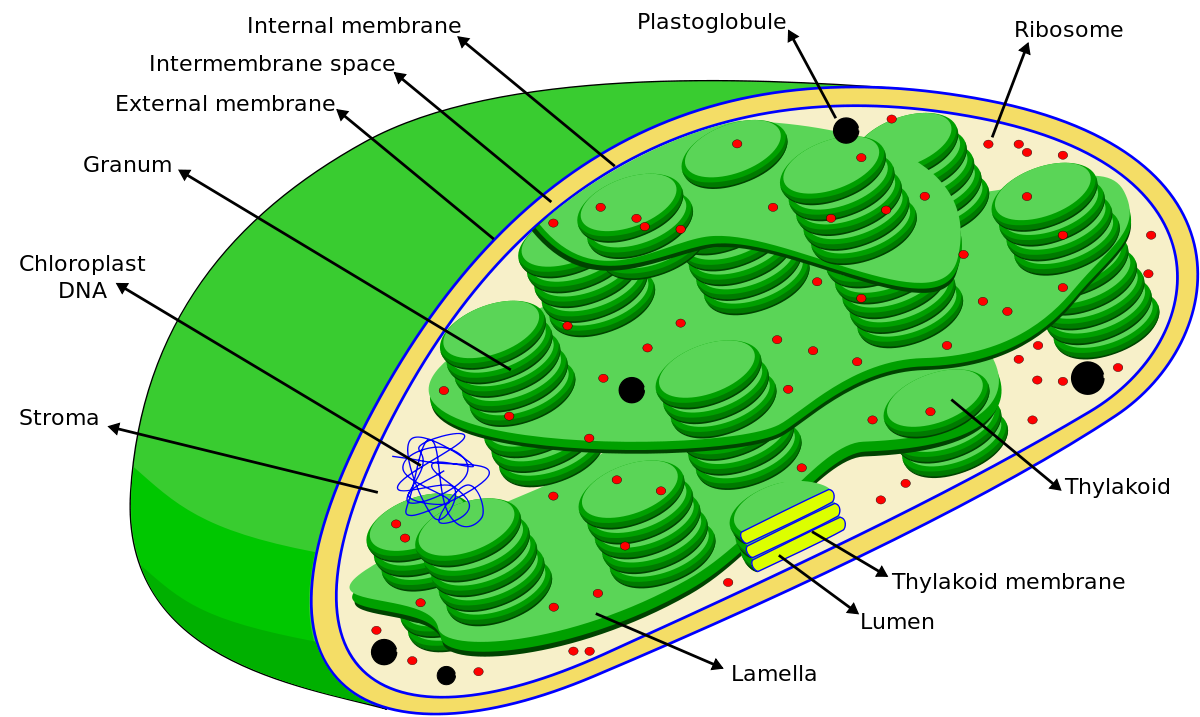
n., Synonyms: chloroplastid; green plastid; chloroleucite
Chloroplast definition: A plastid that contains high amounts of chlorophyll and where photosynthesis takes place
Table of Contents
Chloroplast Definition
What is chloroplast? In biology, a chloroplast refers to the organelle found within the cell of plants and other photosynthetic eukaryotes that is filled with the green pigment called chlorophyll. Etymology: from Greek “chloros”, meaning “green” and “plast”, meaning “form” or “entity”. Synonyms: chloroplastid; green plastid; chloroleucite.
When a eukaryote possesses chloroplasts, it indicates that it can produce its own food. It does so through photosynthesis. Which types of cells contain chloroplasts? Plants are examples of organisms that possess chloroplasts inside their cells. A look at their cells will reveal the presence of numerous chloroplasts that spread throughout the cytoplasm (see leaf anatomy picture below). Each chloroplast contains a light-harvesting system containing chlorophylls. These green pigments absorb light in the blue and red of the electromagnetic spectrum. They, however, reflect the green portion of the spectrum. It is for this reason that plants are green. By contrast, animal cells do not contain chloroplasts. Thus, apart from the presence of a cell wall (i.e. a layer made up of cellulose that accounts for cell rigidity in plants), the presence of chloroplasts is another defining characteristic that could help identify plants from the animals. Other organisms that possess chloroplasts are eukaryotic algae, e.g. green algae. Some photosynthetic bacteria (e.g. phototrophs and cyanobacteria) have chlorophylls in their cells. However, their chlorophylls will not be found inside a double membrane organelle like the chloroplast. Rather, the chlorophyll pigments are located in the thylakoid membrane of a bacterial cell.

Characteristics of Chloroplast
The chloroplast is one of the organelles of a photosynthetic eukaryotic cell. It is a type of plastid (the other types are chromoplasts and leucoplasts). The chloroplasts are identifiable from the other plastids by their color, shape, structure, and function. The chloroplasts are green due to the chlorophyll pigments that occur in abundance. The two most common types are chlorophyll a and b. Other chlorophyll pigments are chlorophyll c, d, and f. Chlorophyll a is present in all chloroplasts whereas other types are present (in varying amounts) depending on the species. In vascular plants, the shape resembles a lens or a disc, and the size is approximately 5µm in length and ~2.5µm in width. (Ref.1) In algae, the shape may vary. They could be round, oval, or tubular.
Structure of Chloroplast
What is the structure of chloroplast? The chloroplast has at least three membrane systems: (1) outer membrane, (2) inner membrane, and (3) thylakoid system. The outer and inner membranes are the double membrane system that is a typical feature of an organelle. The thylakoids are disk-shaped structures that harvest or collect photons from a light source, such as sunlight. Embedded in the thylakoid membrane is the antenna complex consisting of proteins, and light-absorbing pigments, particularly chlorophyll and carotenoids. Hence, the job of the thylakoid is to provide a site for the light reactions of photosynthesis. The stack of thylakoids (resembling a stack of coins) is called granum (plural: grana). The matrix of the chloroplast is referred to as the stroma. It is the thick fluid in between grana. It contains enzymes, molecules, and ions. It is where the light-independent process of sugar formation takes place (the dark reactions of photosynthesis).
Similar to the mitochondria, the chloroplasts are semi-autonomous organelles. They possess their own DNA, which is referred to as chloroplast DNA or cpDNA. Thus, they do not solely rely on the genes contained in the nucleus. They produce certain proteins from their own DNA. (Ref.2)

Chloroplast Functions
What is the function of the chloroplast? Chloroplasts carry out the process of photosynthesis. Their main role is to provide the site for light and dark reactions. It is where inorganic sources, water, and light energy are converted into food, i.e. glucose (a sugar molecule). The chloroplasts are, therefore, important to photosynthetic organisms to produce food on their own and not need to feed on other organisms to survive. Because oxygen is one of the byproducts of photosynthesis, the chloroplasts are a crucial site for producing and releasing oxygen from the cell into the environment. Oxygen is biologically important for its role, in turn, in various biochemical and physiological processes in animals.
For further description and facts on photosynthesis, read Plant Metabolism tutorial.
Chloroplast Evolution
The Endosymbiotic theory was conceptualized to delineate the origin of chloroplasts. (Ref.3) Accordingly, organelles such as mitochondria and chloroplasts were cellular structures in eukaryotic cells that emerged as a result of a primary endosymbiosis that took place millions of years ago between the prokaryotic endosymbionts and the eukaryotic host cells. The eukaryotic cell, being the larger cell, took in the smaller photosynthetic prokaryotes (e.g. cyanobacteria) that consequently enabled them to photosynthesize. Eventually, the prokaryotes evolved and differentiated into plastids, particularly, chloroplasts. These early photosynthetic eukaryotes harboring prokaryotes-turned-organelles are presumed to be the early ancestors of modern plants and algae on Earth. The discovery of the cpDNA in chloroplasts, the similarity in membranes, and the binary fission as a means of reproduction serve as evidence that supports this theory. (Ref.4)
Read also:
What is the Likely Origin of Chloroplasts? – BioTechniques. (2017, December 14). BioTechniques. https://www.biotechniques.com/molecular-biology/when-did-the-chloroplast-evolve/
NOTE IT!
Green sea slugs — the animals that can photosynthesize

One of the distinguishing features of an animal is their lack of a chloroplast. The animal body is devoid of chloroplast, which makes animals incapable of photosynthesis. However, some animals seem to have photosynthetic machinery, which also accounts for their greenish color.
Let’s take for example the eastern emerald elysia (Elysia chlorotica), a green sea slug of the phylum Mollusca. The species is found on the east coast of the United States and in Nova Scotia, Canada. It is one of the few sea slug species that can utilize energy from the sun to produce food as plants would!
How is it possible?
The slug feeds on algae, such as Vaucheria litorea. It sucks out the algal contents with its mouth but it does not fully digest them. Instead, it retains the chloroplasts and stores them inside its gut cells. With the chloroplasts intact and the slug’s translucent body, the chloroplasts can continue to function ultimately harnessing the energy from the sun and converting it into a food energy source that the slug can utilize. This is essential, especially during periods of less food supply. Interestingly, the chloroplasts can remain functional for many months.
This process of sequestering plastids such as chloroplasts of algae by the host and incorporating them into its own cells is called kleptoplasty (or kleptoplastidy).
Another example is the leaf sheep, which is also a sea slug capable of kleptoplasty.
Take the Chloroplast Biology Quiz!
See also
References
- Staehelin, L. A. (2003). Chloroplast structure: from chlorophyll granules to supra-molecular architecture of thylakoid membranes. Photosynthesis Research, 76(1–3), 185–196. https://doi.org/10.1023/A:1024994525586
- Discovery of Chloroplast DNA, Genomes and Genes | Discoveries in Plant Biology. (2019). Worldscientific.Com. https://www.worldscientific.com/doi/abs/10.1142/9789812813046_0002
- Jensen, P. E., & Leister, D. (2014). Chloroplast evolution, structure and functions. F1000Prime Reports, 6. https://doi.org/10.12703/p6-40
- Evidence for endosymbiosis. (2020). Berkeley.Edu. https://evolution.berkeley.edu/evolibrary/article/_0_0/endosymbiosis_04
©BiologyOnline. Content provided and moderated by BiologyOnline Editors.






